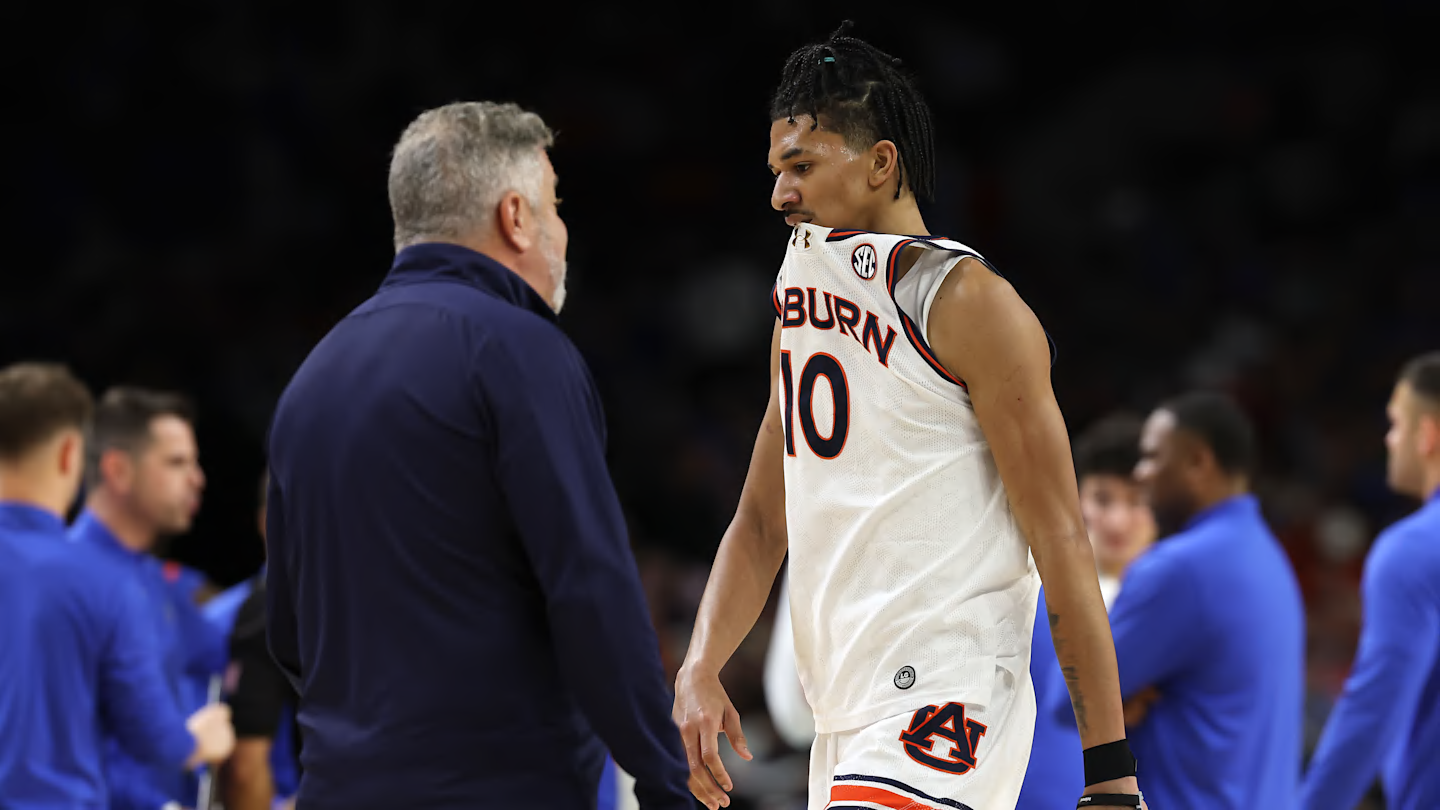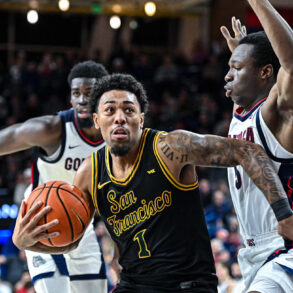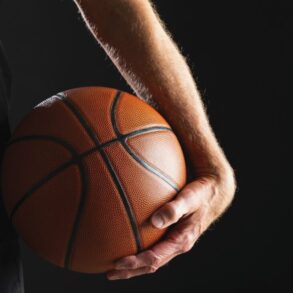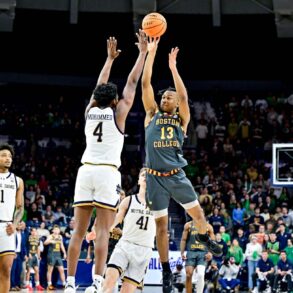
Just like a great hitter in baseball, recruiting in the transfer portal requires a coach to be disciplined and to know what strategy will best pay off for his program. There are different types of home run hitters in America’s pastime: those who always swing big and hope for the best, and those with the skill to look for the right pitch. In college basketball, dozens of reckless coaches follow the first axiom, while a skilled few can consistently succeed at the second. Tennessee’s Rick Barnes has been the epitome of the difficult approach, landing eventual superstars (Dalton Knecht – Northern Colorado and Chaz Lanier – North Florida) from small schools in back-to-back years to go with terrific role players.
Other hitters choose a different approach although. Many Hall of Famers spent long careers striding up to the plate looking to just maximize their on-base percentages. Others waited on that perfect pitch to try and strike it into the gap for a double. Portal recruiting is no different, sometimes a coach just needs the right role player to fill a roster hole. In a different instance, one big swing may be required, along with a few singles.
In the spirit of America’s oldest (baseball) and newest (transfer portal) springtime sports traditions, I have seven awards to hand out to the team’s that best epitomized the various recruiting strategies, and the baseball player who has put that strategy to work at the plate. For comparison sake, I am also listing what program would have won the awards AFTER the 2024-25 season, knowing how everything turned out.
Chris Davis Award – Given to the program that is consistently taking wild swings in the hope of hitting massive home runs, and will surely end up with a few strikeouts as well.
Winner: USC
’25 Season Winner: Kansas
A year after Kansas grabbed a near half dozen talented wings and tossed them all together in an experiment that produced one extra base hit (Zeke Mayo) and a whole bunch of whiffs, USC is loading up their roster with a whole lot of high-ceiling/low-floor players. Jacob Cofie had a few eye-popping moments at Virginia, but never shone through on a roster that was begging for difference-makers. Amarion Dickerson was the Horizon League Defensive Player of the Year and scored twenty-five points while putting a scare into Alabama in the NCAA Tournament, but he shot 27.6% from three and may have jumped too high.
The backcourt has some more certainty, with two proven fantastic players, but Rodney Rice may be asked to be a full time point guard for the first time and Chad Baker-Mazara is always a potential malcontent, who finally showed some signs of maturity last season by not playing Auburn out of a crucial game with mental mistakes (see 2024 NCAA Tournament). Sadly, those two may have to carry a major weigh, since freshman Alijah Arenas is now a wild card, following a nasty car accident that had him briefly in a coma.
Shohei Ohtani Award – Given to the team that did everything that was needed, finding top of the line stars and perfect fitting role players. Just all-around excellence.
Winner: St. John’s
’25 Season Winner: Michigan
Last year, Michigan assembled the legendary double big lineup with Danny Wolf (Yale) and Vlad Goldin (Florida Atlantic), turning Wolf into an NBA prospect in the process, while also assembling a quality starting backcourt with Tre Donaldson (Auburn) and Roddy Gayle (Ohio State). This time around, it’s St. John’s who has brought in an overwhelming amount of talent. The Red Storm should retain last year’s defensive identity, thanks to Dillon Mitchell (Texas) and Oziyah Sellers (Stanford) joining the heart and soul of last year’s group in Zuby Ejiofor.
Rick Pitino also overhauled the offense that failed to come through in the NCAA Tournament loss to Arkansas. Bryce Hopkins (Providence) is the most likely replacement for RJ Luis as to the go-to star, while Ian Jackson (UNC) also packs a serious scoring punch. Jackson, Sellers and Joson Sanon (Arizona State) should seriously improve their floor spacing. Although, there still remains a big question at point guard, where Dylan Darling (Idaho State) is the only veteran with any experience at the position.
Mookie Betts Award – A secondary to the Ohtani Award, this is given to the team that lands one big home run, with smaller, albeit still excellent moves elsewhere.
Winner: Louisville
’25 Season Winner: Florida
Florida took an ascendant returning core, added a dynamite second scorer (Alijah Martin) and frontcourt depth (led by Reuben Chinyelu), and rode that roster all of the way to a National Championship. Louisville has to replace more than the Gators did a year ago, but were aided by landing five-star point guard Mikel Brown Jr a few months back. With swiss army knife J’Vonne Hadley and a deep frontcourt of Kasean Pyror, Ali Khalifa and Khani Rooths already in place, Louisville just needed to a top scorer and another wing or two.
Enter Xavier transfer Ryan Conwell and Virginia transfer Isaac McKneely, either of whom could have a transcendent all-conference season within Pat Kelsey’s system, while both are already very well suited to take on a second or third option role. Add in Adrian Wooley, who led Kennesaw State in scoring and assists as a freshman, as a cover all spots backup for Conwell, McKneely and Brown, and Louisville may have quickly improved of off last year’s surprising rise (see below).
Ichiro Suzuki Award – Given to the team that returns a quality core, and brings in low risk role players to fill in the gaps.
Winner: Florida
’25 Season Winner: Clemson
Clemson went into last off-season seeking defensive anchors on the perimeter and interior, and landed both in Jaeden Zackery (Boston College) and Viktor Lahkin (Cincinnati), to go with a balanced and deep group of offensive options. This time, defending National Champions Florida likely returns their full frontcourt (Alex Condon and Chinyelu are in the NBA Draft with the option to come back). The group included breakout candidate Thomas Haugh, who looks poised to replace one of the primary scorers who graduated.
This still left a gaping hole at point guard, which has been filled by Princeton transfer Xaivian Lee, a unanimous first-team All-Ivy selection the past two seasons. Lee is no Walter Clayton Jr, but he doesn’t have to be. The Gators’ bigs will take on a much more significant role this season; they just needed the distributor to set them up. Florida is also a bit short on shooting, and addressed that with Ohio transfer AJ Brown (38.8% from three).
Brady Anderson Award – Given to the program that makes a sudden (and shocking) rise year over year, thanks largely to a portal-driven overhaul.
Winner: Iowa
’25 Season Winner: Louisville
Fresh off the 12-52 two-year stretch that was the Kenny Payne Era, Louisville fans were just looking for competence in Pat Kelsey’s first season. Instead, he brought in veteran guards Chucky Hepburn (Wisconsin), Terrance Edwards Jr (James Madison), Reyne Smith (College of Charleston), and J’Vonne Hadley (Colorado), and made the NCAA Tournament. The end of the Fran McCaffery Era at Iowa was much better, but the Hawkeyes have been far from their best the last few years and have been largely forgotten about, even following the hire of Drake coach Ben McCollum.
Iowa’s foundation is built from Drake transfers, led by the Missouri Valley Player of the Year, point guard Bennett Stirtz, starting center Cam Manyawu and the conference’s Sixth Man of the Year Tavion Banks. Manyawu will be paired with the Horizon League Player of the Year Alvaro Folgueiras (Robert Morris), an elite rebounder and secondary playmaker as a stretch big, whose defensive shortcomings will be covered up playing at the four. Add in another floor spacer in Kansas State transfer Brendan Hausen, and McCollum has a chance to sneak up on the Big Ten in his first season.
Mike Hessman Award – Given to the mid-major team that overwhelms their conference with a massively talented incoming group of transfers. In honor of the all-time minor league home run leader.
Winner: McNesse State
’25 Season Winner: UNC Wilmington
Last spring, McNesse State brought in a portal class that included two starters (Quadir Copeland and Joe Charles) and the entirely of their bench (led by Sincere Parker and Brandon Murray), for a team that rampaged through the Southland (19-1 conference record), on the way to an NCAA Tournament win over Clemson, with Murray and Copeland as the leading scorers in that game. This off-season, UNC Wilmington has assembled a group of CAA All-Stars to join two of the top six players from last season’s conference champion.
CJ Luster led Stony Brook in scoring, Christian May started for CAA regular season champion Towson, Madison Durr led Monmouth in assists, and Jahnathan Lamothe was the top rebounder for North Carolina A&T. It’s a never-before-seen strategy of picking off proven top-notch players from lesser schools in the same conference. This group doesn’t feature a center, but that spot will be manned by Gavin Walsh, an all-conference player at Binghamton and Patrick Wessler, who played sparingly at Virginia Tech.
Kirk Gibson Award – In honor of the former MVPs legendary pinch hit home run to win game 1 of the 1988 World Series, this is given to the team with a fantastic returning core, who needed just one more missing piece.
Winner: Houston
’25 Season Winner: Purdue
After losing Jamal Shead to the NBA, Houston’s Kelvin Sampson brought in a rare transfer in Oklahoma point guard Milos Uzan to join a core that would eventually make it all the way to the National Championship game. This year, another coach who rarely brings in transfers, Purdue’s Matt Painter looked that way.
The Boilermakers will get a fourth and final season with their three stars, Braden Smith, Foster Loyer and Trey Kaufman-Renn, while also bringing back a handful of role players. But after failing to properly replace Zach Edey with freshmen and returners last off-season, Purdue tried going the portal route. Enter Oscar Cluff, a 6’11” senior and the most dominant force in the Summit League (17.6 ppg, 12.3 rpg at South Dakota State). Cluff doesn’t need to become a star at even close to Edey’s level, but Painter will look to him to be the singular dominant low-post scorer that his offense requires.
This post was originally published on this site be sure to check out more of their content.









